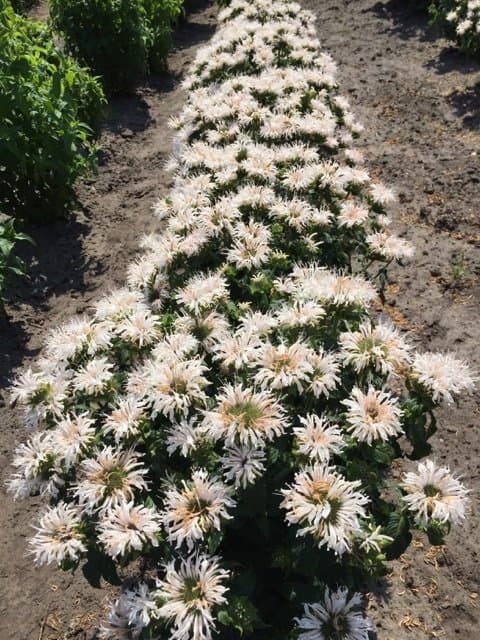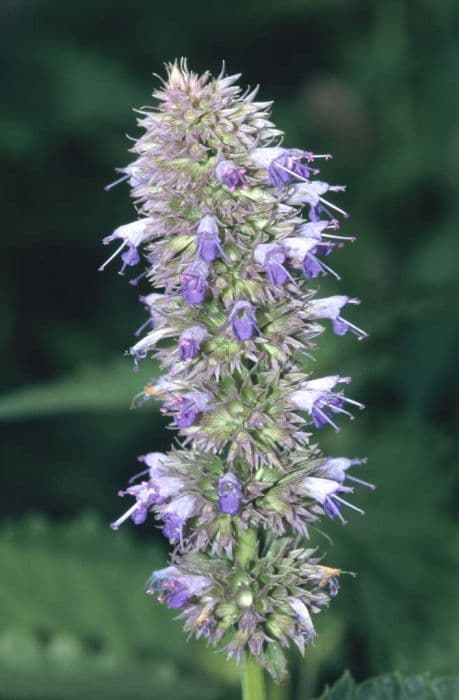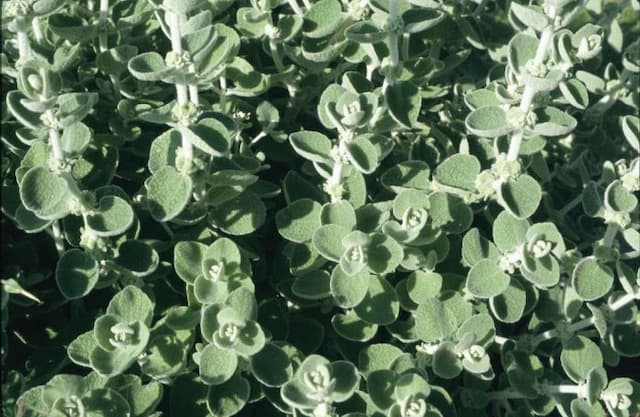Monarda 'Bee Bright' Monarda didyma Bee-bright = 'Monbebr' (Bee-you Series)

ABOUT
[Bee-Bright] is a compact plant to around 45cm tall bearing pure white flowers above the mounded foliage in summer
About this plant
 Names
NamesFamily
Lamiaceae
Synonyms
Bee Balm, Scarlet Monarda, Oswego Tea, Crimson Beebalm, Red Bergamot, Scarlet Beebalm
Common names
Monarda didyma, Monarda clinopodia, Monarda angustiloba, Monarda dumetorum, Monarda media, Monarda russeliana.
 Characteristics
CharacteristicsLife cycle
Perennials
Foliage type
Deciduous
Color of leaves
Green
Flower color
Red
Height
2-3 feet (0.6-0.9 meters)
Spread
2 feet (0.6 meters)
Plant type
Herb
Hardiness zones
4
Native area
North America
Benefits
 General Benefits
General Benefits- Attracts Pollinators: 'Monbebr' is known to attract bees, butterflies, and other beneficial insects, which not only helps pollinate other plants in the garden but also supports biodiversity.
- Aesthetic Appeal: With its vivid red flowers and aromatic foliage, it adds a splash of color and pleasant fragrance, enhancing the visual and sensory garden experience.
- Easy to Grow: It's relatively easy to cultivate in a variety of garden settings, making it suitable for both novice and experienced gardeners.
- Hummingbird Friendly: The tubular flowers of the Bee-balm are particularly attractive to hummingbirds, providing a nectar source for these charming birds.
- Drought Tolerant: Once established, it has good drought tolerance, requiring less watering and maintenance than many other garden perennials.
- Disease Resistance: The Bee-you Series, including 'Monbebr', has been bred for improved resistance to common diseases like powdery mildew, which frequently affects the Monarda genus.
- Edible Uses: Parts of the plant are edible and can be used in teas and culinary dishes, although this should be approached with care and proper knowledge.
- Long Blooming: It has a long flowering period, often lasting several weeks, which ensures lasting color in the garden or landscape.
- Deer Resistant: Its aromatic foliage can be a deterrent to deer, which might otherwise cause damage to garden plants.
- Soil Adaptability: It can adapt to a wide range of soil types, though it prefers moist, well-drained soils.
 Medical Properties
Medical Properties- Antimicrobial: Monarda didyma has been traditionally used for its antimicrobial properties to help fight bacterial and fungal infections.
- Antiseptic: The plant's essential oils have antiseptic qualities and have been used topically to clean wounds and prevent infections.
- Carminative: It has been used to relieve digestive issues, such as bloating and gas, due to its carminative effects.
- Diaphoretic: Monarda didyma can induce sweating and has been used historically to help reduce fevers.
 Air-purifying Qualities
Air-purifying QualitiesThis plant is not specifically known for air purifying qualities.
 Other Uses
Other Uses- Culinary Herb: Bee Balm leaves and flowers can be used to flavor teas, salads, and baked goods, adding a mixture of minty and citrusy notes to dishes.
- Edible Garnish: The vibrant flowers of Bee Balm make an attractive and edible garnish for desserts and cocktails, providing a pop of color and a subtle hint of flavor.
- Natural Fabric Dye: Bee Balm can be used to make a natural dye, imparting a range of pink to purple hues to fabrics, depending on the mordant used.
- Companion Planting: When planted in the garden, Bee Balm can attract beneficial pollinators and help nearby plants by increasing pollination rates.
- Aromatherapy: The essential oils of Bee Balm can be used in aromatherapy to create a calming and relaxing atmosphere.
- Crafting Potpourri: Dried Bee Balm flowers and leaves can be incorporated into potpourri mixes to contribute a pleasant aroma to a room.
- Floral Arrangements: Fresh or dried Bee Balm flowers can be used in floral arrangements for their aesthetic appeal and fragrance.
- Natural Pest Repellent: Bee Balm has properties that can deter certain insects, making it useful in the garden to protect other plants.
- Photography and Art: Bee Balm's striking flowers make it an excellent subject for botanical photography and artwork, capturing its vivid colors and forms.
- Soil Erosion Control: Bee Balm's dense growth habit can help reduce soil erosion in garden beds and on slopes.
Interesting Facts
 Feng Shui
Feng ShuiBee Balm is not used in Feng Shui practice.
 Zodiac Sign Compitability
Zodiac Sign CompitabilityBee Balm is not used in astrology practice.
 Plant Symbolism
Plant Symbolism- Attractiveness: Monarda didyma, also known as Bee Balm, symbolizes attraction due to its ability to draw in pollinators like bees, butterflies, and hummingbirds with its bright, tubular flowers.
- Healing: Historically, Bee Balm was used by Native Americans for its medicinal properties, which makes it a symbol of healing and relief.
- Balance: The 'Monbebr' variety in the Bee-you Series conveys balance owing to its equal appeal to a diverse array of pollinators, as well as its harmonious growth patterns.
- Vibrancy: The vivid red flowers of Bee Balm symbolize vibrancy and energy, echoing the lively ecosystem it supports.
- Prosperity: With its lush and abundant growth, Bee Balm can symbolize prosperity and generosity, reflecting its giving nature within the garden.
 Water
WaterBee Balm requires regular watering to maintain evenly moist soil, especially during hot and dry periods. It’s best to water deeply once or twice a week, providing about one inch of water each time, which equates to approximately 0.6 gallons per square yard of soil. Water at the base of the plant to avoid wetting the foliage, as this can promote disease. During particularly hot weather, you may need to increase the frequency of watering, but always check the soil moisture first to avoid overwatering. Reduce watering in the fall as the plant prepares for dormancy.
 Light
LightBee Balm thrives in full sun to partial shade. It prefers a spot that receives at least six to eight hours of direct sunlight per day. In areas with very hot summers, some afternoon shade can help prevent the leaves from scorching, while still providing enough light for abundant flowering. Avoid deep shade, as this can lead to poor growth and fewer flowers.
 Temperature
TemperatureBee Balm is hardy in a range of temperatures and can survive winter lows down to -30°F, but it grows best when nighttime temperatures are above 50°F and daytime temperatures are between 60°F and 80°F. It can tolerate high summer temperatures up to 90°F, but should be protected from extreme heat. Adequate air circulation around the plant can help mitigate the effects of high temperatures.
 Pruning
PruningPruning Bee Balm is important to encourage bushier growth and more flowers. Deadhead spent blooms regularly to promote continuous flowering throughout the season. In spring, cut back the previous year's growth to a few inches above ground level to allow for fresh, vigorous growth. Pruning in the late fall or early spring can also help prevent disease and improve air circulation.
 Cleaning
CleaningAs needed
 Soil
SoilBee Balm requires a well-draining soil rich in organic matter with a pH range of 6.0 to 7.0. A mixture of garden soil, compost, and a small part of sand or perlite provides optimal conditions for its growth.
 Repotting
RepottingBee Balm, when grown in containers, should be repotted every 1-2 years into a slightly larger pot with fresh soil to replenish nutrients and accommodate growth.
 Humidity & Misting
Humidity & MistingBee Balm thrives in average humidity conditions; it does not have specific humidity requirements, making it adaptable to most environments provided it's well-watered.
 Suitable locations
Suitable locationsIndoor
Place Bee Balm near a sunny window and water regularly.
Outdoor
Full sun to part shade and moist, well-drained soil.
Hardiness zone
4-9 USDA
 Life cycle
Life cycleMonarda didyma, commonly known as Bee Balm, begins its life as a seed that germinates in early spring, requiring stratification or a period of cold to break dormancy. Once germinated, the seedling grows rapidly, developing into a vegetative plant with characteristic square stems and lance-shaped leaves. By mid to late summer, it reaches maturity and produces vividly colored tubular flowers that attract a variety of pollinators, particularly bees and hummingbirds. After pollination, the flowers give way to seed heads that, if not deadheaded, will release seeds and can self-sow. As a perennial, Bee Balm enters a period of dormancy in the fall, with its aerial parts dying back after the first hard frost. The plant overwinters through its root system and will re-emerge the following spring to complete the cycle again.
 Propogation
PropogationPropogation time
Spring to early summer
The Monarda didyma, commonly known as Bee Balm, can be propagated most effectively through division. This is best done in the early spring before new growth begins or in the fall as the plant goes dormant. To propagate by division, carefully dig up an established Bee Balm clump, ensuring that you keep a generous amount of soil around the roots. Gently separate the clump into smaller sections, each with several shoots and a portion of the root system. Replant these divisions promptly, spacing them about 18 inches apart (roughly 45 centimeters) to ensure adequate room for growth. Water the newly planted divisions thoroughly to help establish them. This method is efficient as it maintains the clonality of the cultivar, allowing gardeners to expand their Bee Balm plantings while preserving the desirable traits of the 'Monbebr' variety.









